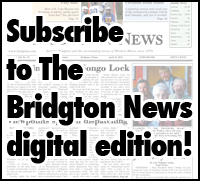Committee suggests access improvements to Ham Bridge
By Wayne E. Rivet
Staff Writer
As the town nears taking ownership of the Bridgton Memorial School property, Open Space Committee members see a need to upgrade pedestrian access to the Ham Bridge, which spans Stevens Brook into Pondicherry Park.
“Our main concern is safe pedestrian access from the Memorial School area to the Ham Bridge…The bridge does get a significant amount of use,” Matt Markot, OSC member, told the Bridgton Select Board Tuesday night. “We think this is a good time to be thinking about this issue as I know the town is expecting to take ownership of the Memorial School site at some point soon.”
The bridge was constructed 15 years ago, and last year, Loon Echo Land Trust installed an accessible 60-foot ramp onto the bridge.
The intent of the Ham Bridge when it was installed was to create an entryway to Pondicherry Park for Stevens Brook Elementary School students.
According to the OSC’s report to the Select Board, pedestrian use of the road goes back to 2009 when the Ham Bridge was first installed, and predates the increase in use of the road by the Public Works Department that coincided with the streetscape redesign and sewer project. The bridge, which is owned by the town, was funded through the Kendal C. and Anna Ham Charitable Foundation.
“Despite the increase of motorized DPW traffic on the road, it is still used significantly by Stevens Brook students and pedestrians,” the report says. “In the future, when the town receives the Memorial School property, it is conceivable that pedestrian use of the road and the Ham Bridge will increase even more. This is a safety concern and liability for the town. Pedestrians should not share space with moving heavy equipment and vehicles.”
The committee recommends installing a split rail fence that separates motorized traffic on the road from pedestrians. The recommended corridor width for pedestrian travel is 5-feet.
“The pedestrian access for Salmon Point Beach is a good example of what the committee envisions and recommends,” the report says.
The road is currently guarded by a sign that states “Employees Only.” The Committee recommends that additional signage be considered to alert pedestrians that they may proceed to the Ham Bridge.
Markot said the OSC worked up estimate of “what we think it might cost to build it and have a contractor install it, understanding the limitations of capacity the Public Works Department has. This is our recommendation, but certainly there may be other ways to accomplish the same goal…Our primary concern is safe public access.”
The estimate:
• Length of pedestrian corridor from Memorial School Site to Ham Bridge: 640 feet.
• Estimated cost for split rail fencing and contractor installation: $5,000.
• Estimated cost for gravel surface material and contractor installation: $3,000.
The Committee’s recommendation is to consider the addition of these costs to the Pondicherry Park budget line item for 2025.
The town does carry a Pondicherry Park Reserve Account, which could be tapped to fund the project.
No action was taken on the proposal, but will likely resurface during upcoming budget preparations.
In other business:
Funding Freeze — While a judge put President Donald Trump’s freeze on federal grants and funding programs on a temporary hold, Maine towns were urged to be prepared.
Select Board Chairman Bob McHatton opened Tuesday’s meeting noting the freeze would impact some local operations and projects. Local department heads were put on notice.
Later in the meeting, Interim Town Manager Georgiann Fleck also addressed the matter.
The Big Dip — Len Rudin says the condition of Highland Point’s road is so bad “an automobile company could test shock absorbers” there.
“That’s how bad it is out there,” said Rudin, who is president of the Highland Point Association. “We just wanted to bring it to your attention. I’ve been here since 2002. There were some minor repairs to huge dips that were there, but at the present time, the road has so many dips, it is in such terrible condition that they (town officials) said we need to work on it. It would take anywhere from two to five years to finish the work. A comment was made that it would break the Public Works Department’s budget to fix it in one year. That’s how severe the problem is.”
With the budget season coming, Rudin pushed for the Select Board to allot some funding to fix some portions of the road.
Association vice president Deb Brusini offered Public Services Director David Madsen somewhat of a trouble spot road map.
A neighbor’s son is a civil engineer, and he spent some time reviewing the 2.5 miles of roadway, “measuring every dip, the depth of it, the size of it and its location,” Brusini said. She passed a copy of the report to Madsen, who responded, “I absolutely would love to have that report.”
“When those roads were built, they were built absolutely lousy. You folks living out there are very, very lucky that the town took those roads over,” Select Board Chairman Bob McHatton said. “Otherwise, you’re repairing those all yourself, out of your own pockets.
Madsen said the plan is to repair some of the worst spots, but “we’re not going to be doing a full rebuild of the road.” Over the next few years, Public Works will tackle the “really bad spots.”

